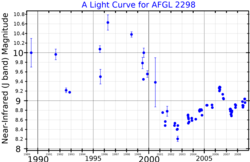V1672_Aquilae
AFGL 2298
Star in the constellation Aquila
AFGL 2298, also known as IRAS 18576+0341, is a luminous blue variable star (LBV) located in the constellation Aquila, very close to the galactic plane. Its distance is not well known; it may be anywhere between 23,000 and 42,000 light years (7,000 to 13,000 parsecs) away from the Earth.[4] Despite being extremely luminous, it is extremely reddened by interstellar extinction, so its apparent magnitude is brighter for longer-wavelength passbands; in fact, in visual wavelengths it is completely undetectable.[7]
AFGL 2298 has an absolute bolometric magnitude of −11.25,[1] making it one of the most luminous stars known. Indeed, many of the hottest and most luminous stars known are luminous blue variables and other early-type stars. However, like all LBVs, AFGL 2298 is highly variable and the bolometric magnitude refers to its peak luminosity.[1] Its status as an LBV was confirmed in 2003.[4]
Like most extremely massive stars, AFGL 2298 is undergoing mass loss.[5] For example, in 2005 it was estimated to be losing 3.7×10−5 solar masses each year,[5] although the rate of mass loss itself varies frequently and dramatically.[1] The stellar mass is currently being ejected as a nebula around the star (similar to AG Carinae), which was imaged by the Very Large Telescope in 2010.[8] The nebula was found to be fairly circular, and the properties of the dust appeared to be constant throughout the entire nebula.[8]
